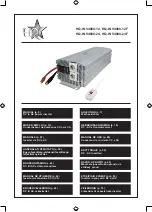
Read the full manual before using this product
16
Appendix 2. Battery desulfation cycle
The desulphation cycle is marked in red in the manual because this is a very dangerous
setting. Before attempting to use this cycle, you need to have good understanding what it does,
how and when to use it.
What causes sulphation?
This can occur with infrequent use of the batteries or if the batteries have been left discharged so
low that they will not accept a charge.
What is a desulphation cycle?
This cycle is a very high voltage charging cycle designed to try to break down the sulphate “crust”
that is preventing the battery plates from taking a charge, and thus allowing the plates to clean up and
accept a charge once again.
Please note: this cycle is only suitable for open lead acid batteries
.
How to use this cycle?
•
Ensure that the battery bank is totally isolated from everything else; the high voltage applied
by this setting could destroy all your electronics and other electrical equipment still connected to
the batteries.
•
Make sure the battery compartment is very well ventilated and battery caps are removed.
•
Turn the inverter on, switch the battery type to the correct position, confirm and turn the
inverter off. Then connect the AC power on to the inverter.
•
Because this is such a dangerous feature there is a 4 hour time out period built into the
programme. However, on a very large battery bank this may not be enough and the unit may need
to be switched off and on again to do another cycle.
•
Don’t forget to change the battery type back to normal at the end of the cycle and turn the
inverter Off / On for settings to take the effect.
What to expect on this cycle?
It is recommended that you monitor the voltage of the sulphated battery bank. When you switch on
the cycle, the voltage should go to the full 15.5V very fast (within minutes). This is because the batteries
cannot accept the charge (assuming they are sulphated). However, over a period of 1-2 hours the
voltage should start to drop (as the plates start to clean and batteries start to take charge) the voltage
could drop way down to about 12.5 volts, then start to rise. This shows that the batteries are now taking
a charge and starting to fill up. In this case it would be safe to switch the unit off and select your normal
battery type. You may need to repeat the process a few times.
This is a professional tool. Never leave the system unattended when using this
mode. If the battery temperature reaches 50°C, or you come across any other
irregularities, stop the process immediately.
www.ato.com
18005851519
Global Shipping

































